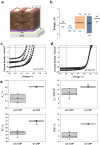Planar heterojunction perovskite solar cells with superior reproducibility
- PMID: 25377945
- PMCID: PMC4223662
- DOI: 10.1038/srep06953
Planar heterojunction perovskite solar cells with superior reproducibility
Abstract
Perovskite solar cells (PeSCs) have been considered one of the competitive next generation power sources. To date, light-to-electric conversion efficiencies have rapidly increased to over 10%, and further improvements are expected. However, the poor device reproducibility of PeSCs ascribed to their inhomogeneously covered film morphology has hindered their practical application. Here, we demonstrate high-performance PeSCs with superior reproducibility by introducing small amounts of N-cyclohexyl-2-pyrrolidone (CHP) as a morphology controller into N,N-dimethylformamide (DMF). As a result, highly homogeneous film morphology, similar to that achieved by vacuum-deposition methods, as well as a high PCE of 10% and an extremely small performance deviation within 0.14% were achieved. This study represents a method for realizing efficient and reproducible planar heterojunction (PHJ) PeSCs through morphology control, taking a major step forward in the low-cost and rapid production of PeSCs by solving one of the biggest problems of PHJ perovskite photovoltaic technology through a facile method.
Figures





References
-
- Sariciftci N. S., Smilowitz L., Heeger A. J. & Wudl F. Photoinduced electron transfer from a conducting polymer to buckminsterfullerene. Science 258, 1474–1476 (1992). - PubMed
-
- Yu G., Gao J., Hemmelen J. C., Wudl F. & Heeger A. J. Polymer photovoltaic cells enhanced efficiencies via a network of internal donor-acceptor heterojucntions. Science 270, 1789–1791 (1995).
-
- Kim M. et al. Electrical performance of organic solar cells with additive-assisted vertical phase separation in the photoactive layer. Adv. Energy Mater. 4, 1300612 (2014).
-
- O'regan B. & Grfitzeli M. A low-cost, high-efficiency solar cell based on dye-sensitized. Nature 353, 737–740 (1991).
-
- Yella A. et al. Porphyrin-sensitized solar cells with cobalt (II/III)–based redox electrolyte exceed 12 percent efficiency. Science 334, 629–634 (2011). - PubMed
Publication types
LinkOut - more resources
Full Text Sources
Other Literature Sources
Research Materials

